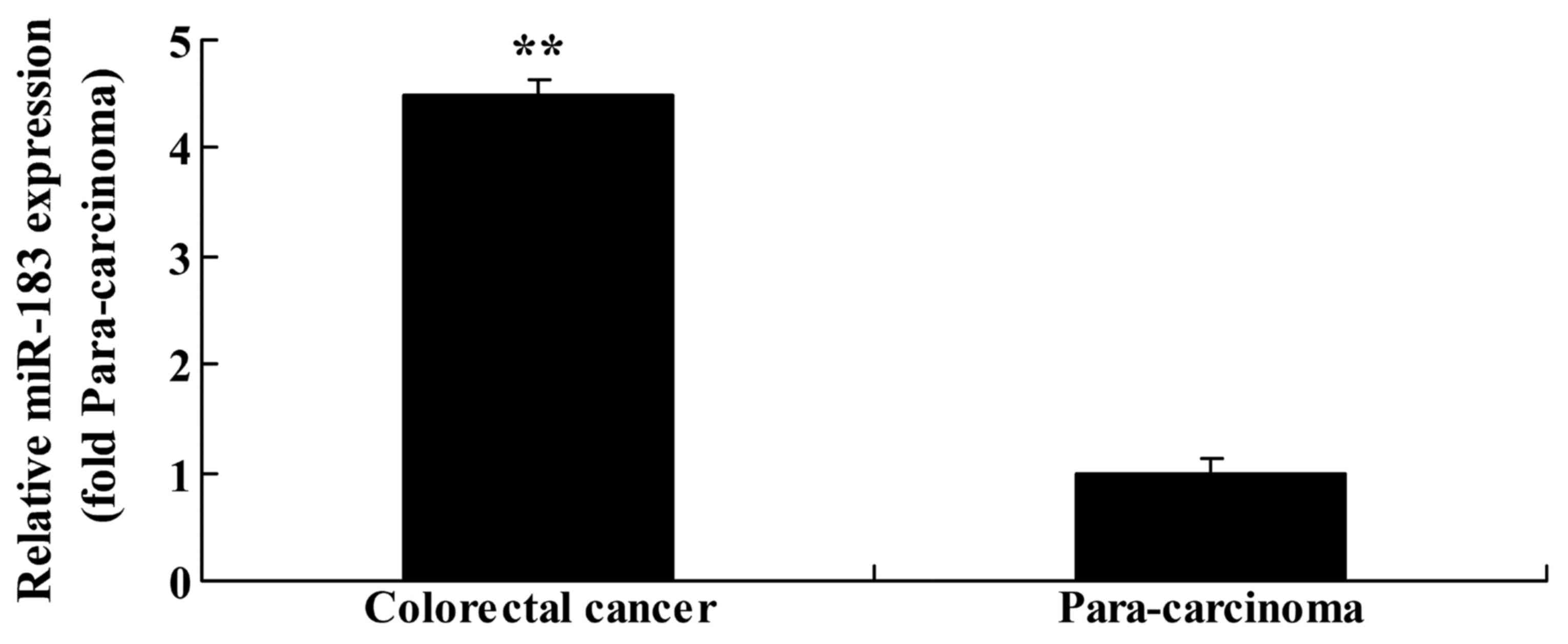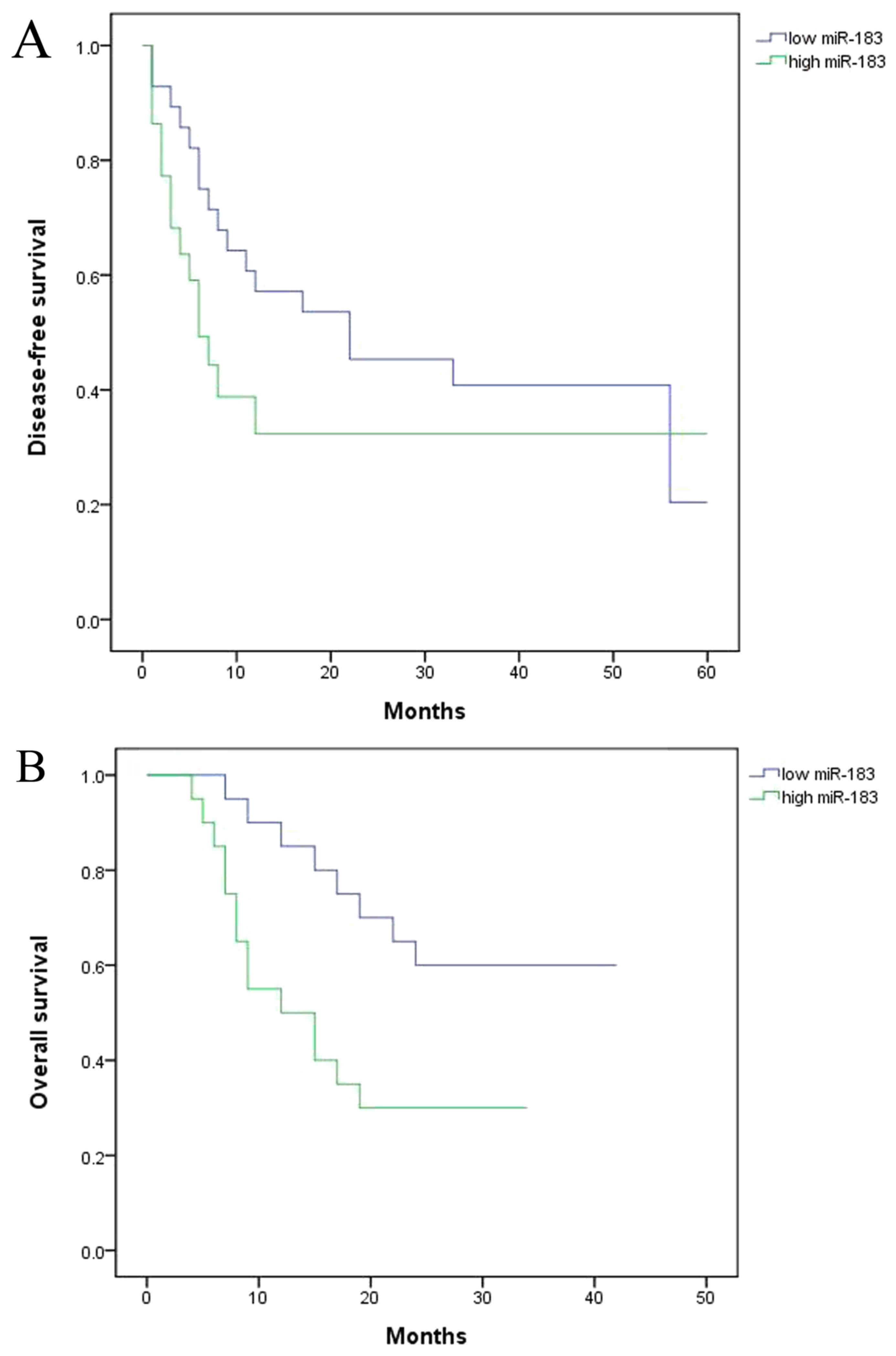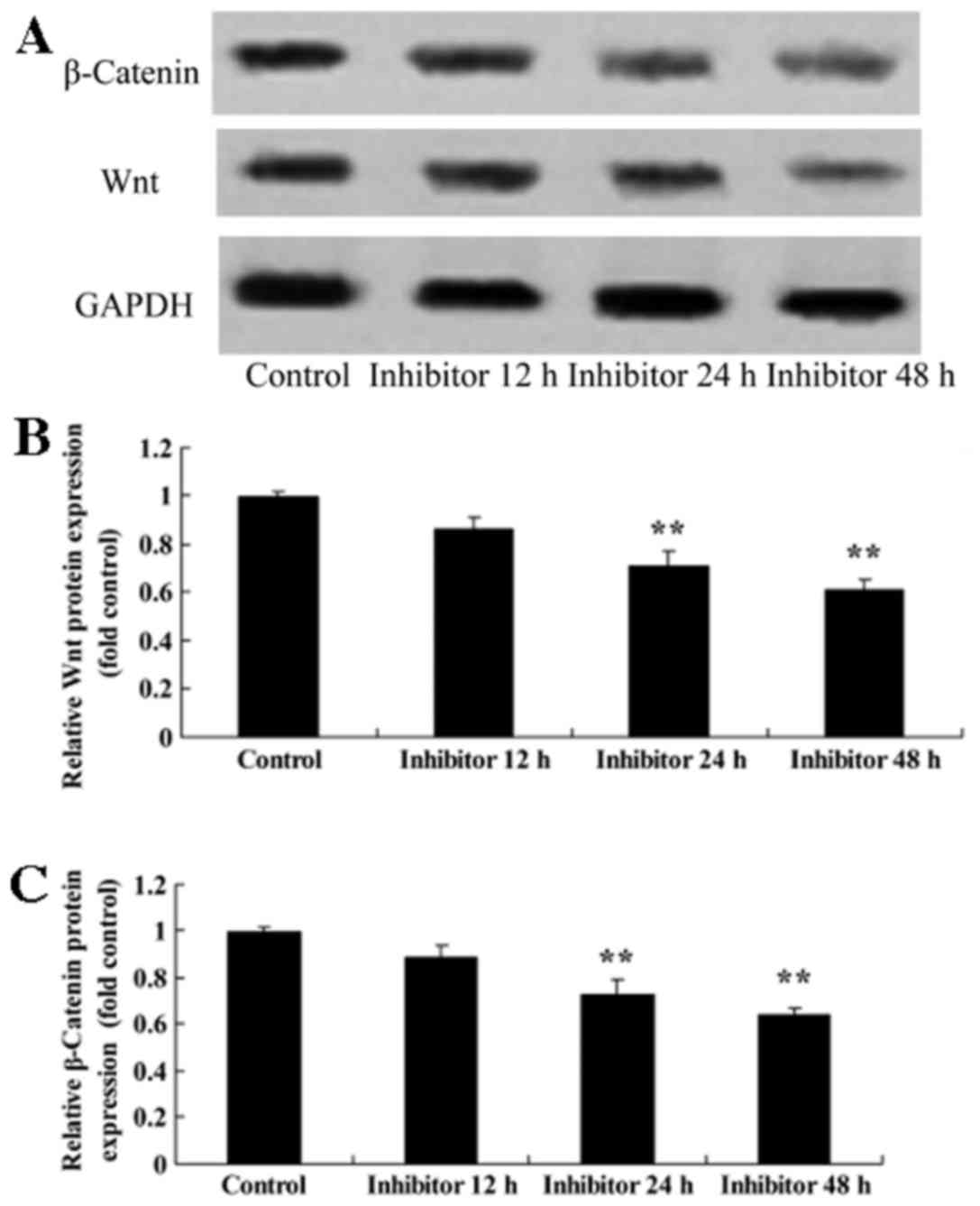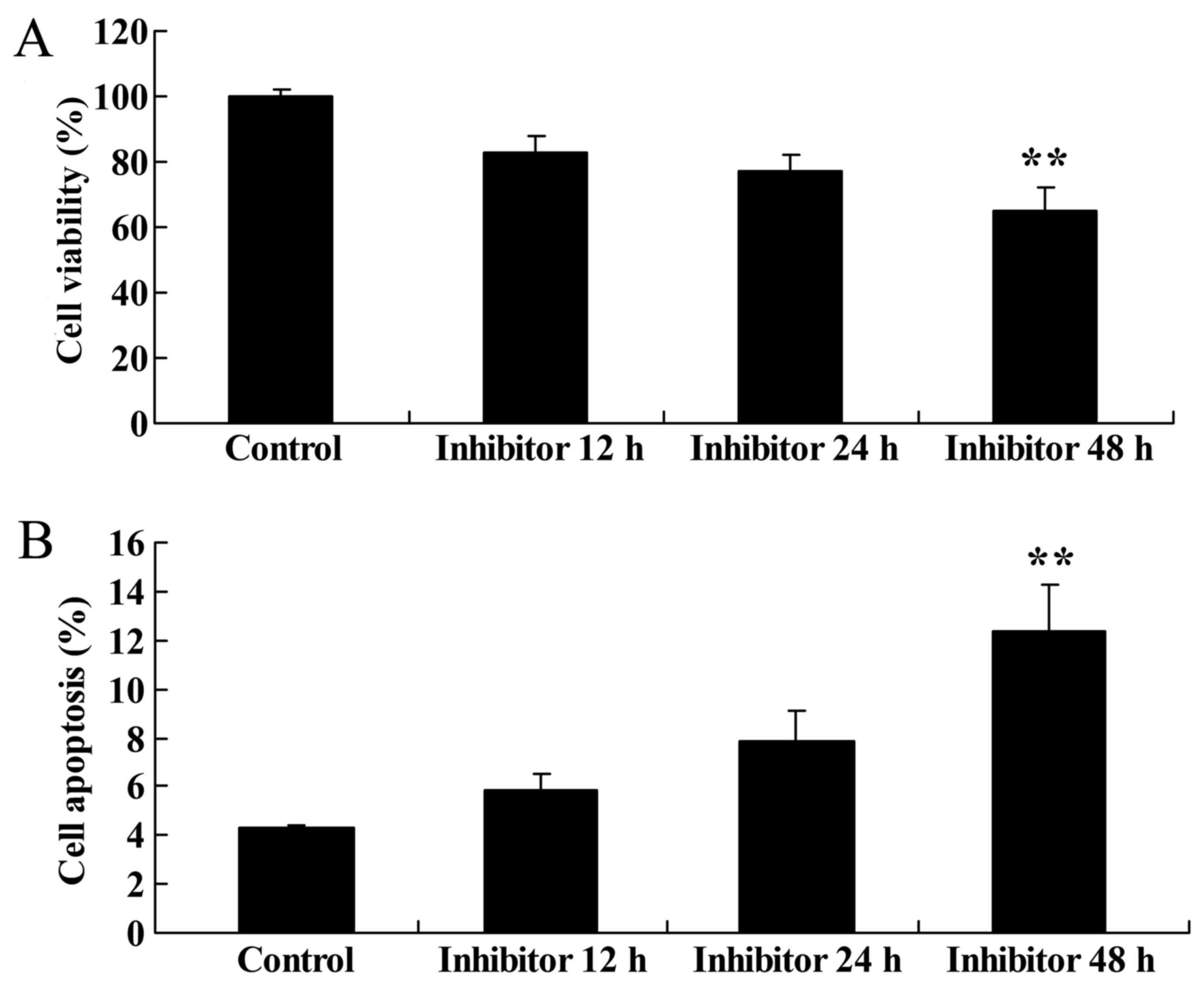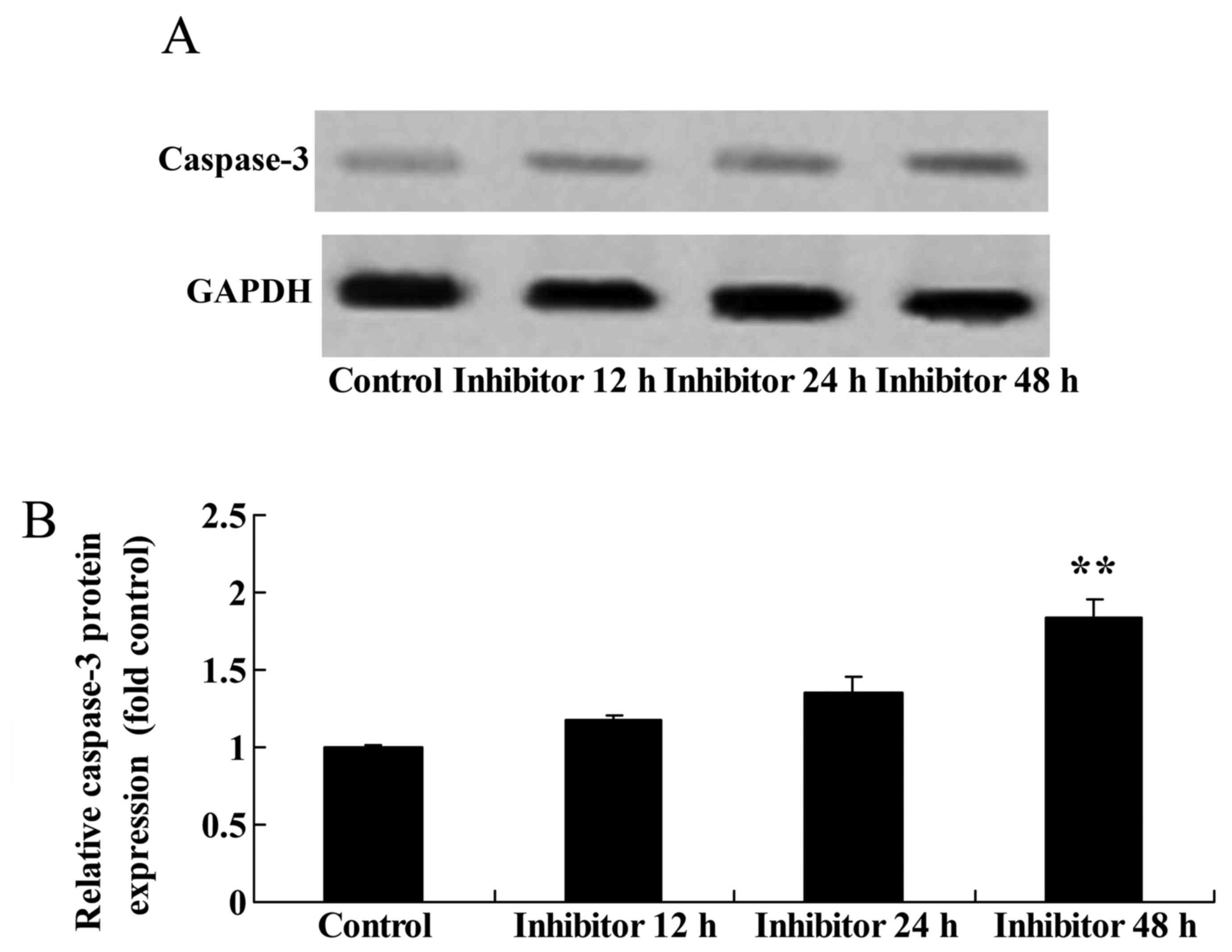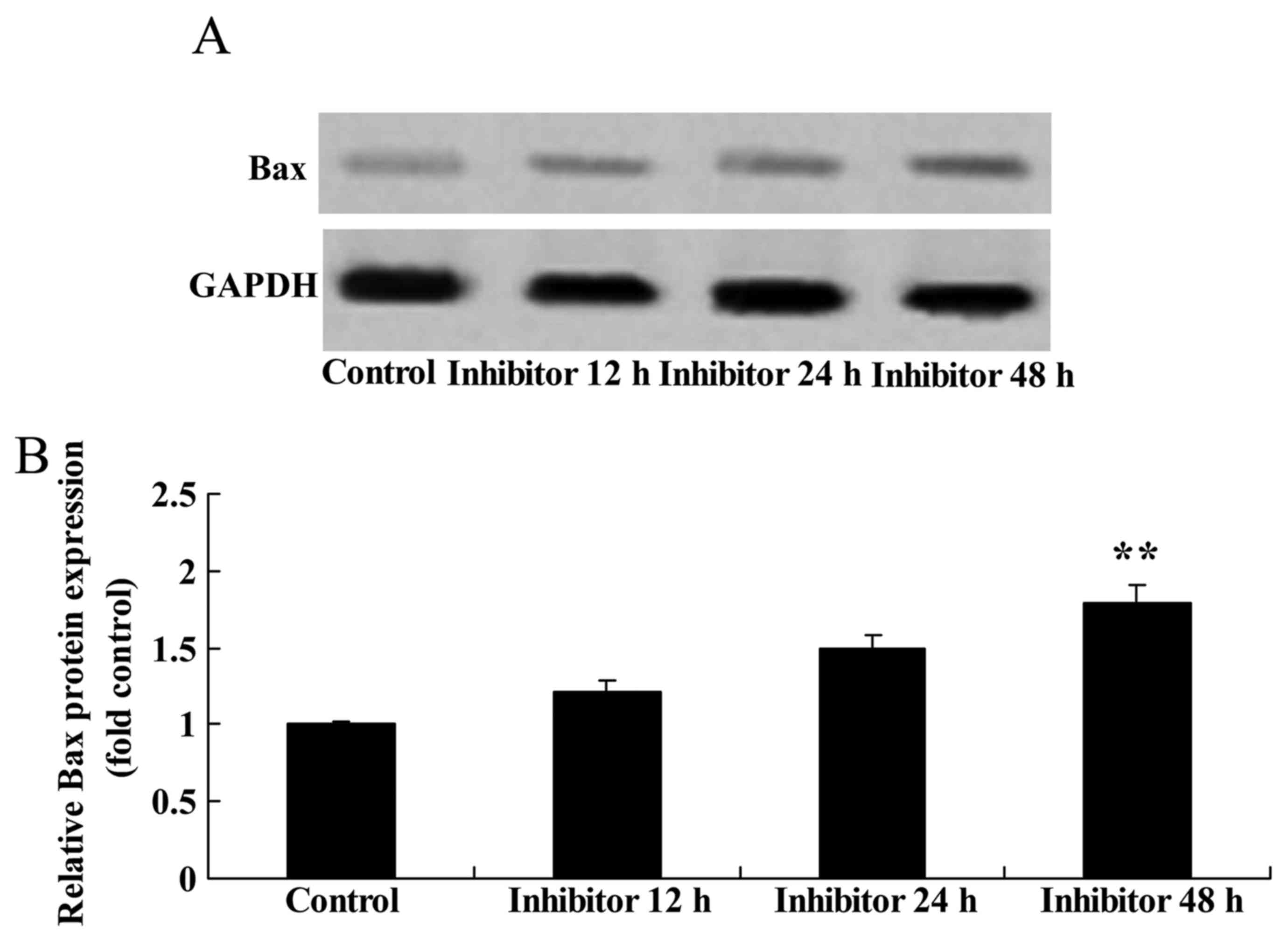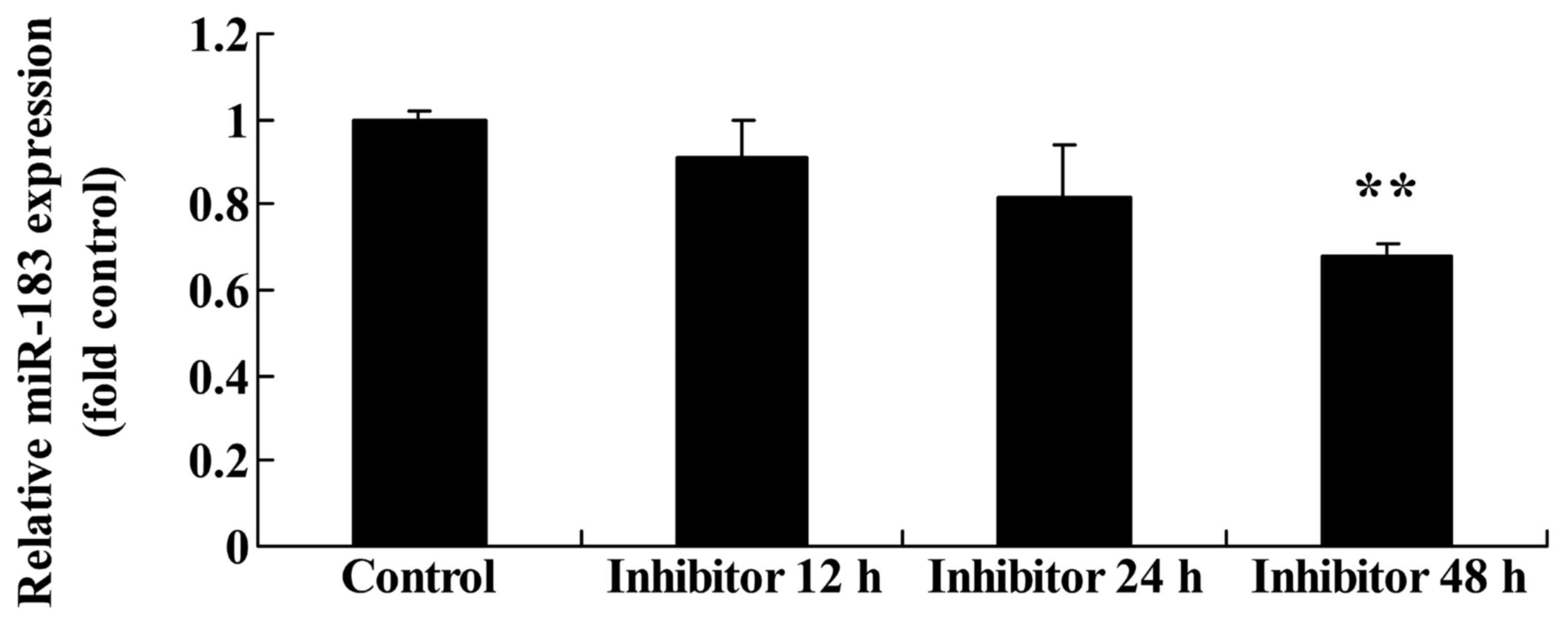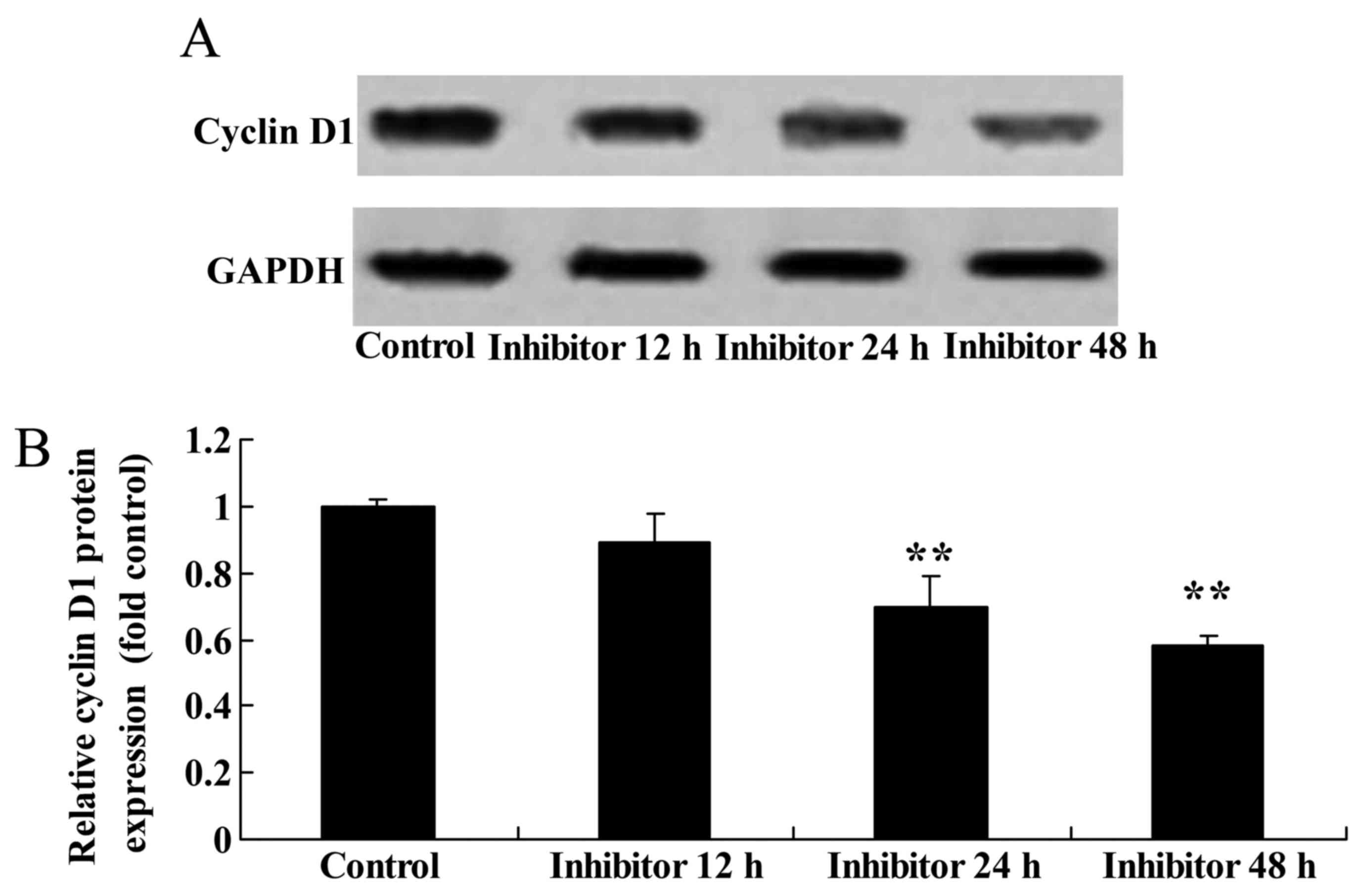Wnt/catenin β1/microRNA 183 predicts recurrence and prognosis of patients with colorectal cancer
- Authors:
- Published online on: January 26, 2018 https://doi.org/10.3892/ol.2018.7886
- Pages: 4451-4456
Abstract
Introduction
Intestinal cancer is a malignant lesion of the mucous epithelium caused by multiple environmental or heritable carcinogenic factors and was the third most common gastroenteric tumor, and a common malignant tumor in 2012 (1). In the United States, 160,000 new cases and ~57,000 colorectal cancer-associated mortalities were reported in 2012. Globally, 900,000 additional cases of and 500,000 mortalities due to colorectal cancer are reported annually in 2012 (2). Globally, the incidence rate of colorectal cancer ranks second among lethal tumors, and threatens human health (3). Epidemiological studies have revealed that colon cancer-associated morbidity exhibits regional differences. Areas of increased incidence include Western Europe, North America, New Zealand and Australia. Areas of moderate incidence include Latin America, and southern and eastern Europe (4). Areas of decreased incidence include South America, Africa and Asia. The morbidity and mortality of colorectal cancer differs between areas of increased and decreased incidence (5).
The study of human microRNA (miRNA/miR) has advanced in previous years. The number of submitted human mature miRNAs increased from 870 to 1921 between March 2009 and November 2011 (6). A given miRNA may regulate >100 genes (6). It is predicted that >5,300 genes, 30% of all human genes, are regulated by miRNAs (7).
Alterations to miRNA expression in early stage colorectal cancer have been reported (8). MiRNA clone technology has detected 28 miRNAs in colorectal cancer and surrounding normal mucosal tissues, including miR320, miR321, miR200c, miR143 and miR145 (9). The expression of miR143 and miR145 was decreased compared with the surrounding normal mucosal tissues. Bandres et al (10) detected the expression of 156 types of miRNA in 15 colorectal cancer cell lines and compared this result with miRNA expression in the normal human colorectal cell line CCD-18C0. The results of that comparison revealed that the expression of 13 miRNAs differed significantly between the colorectal cancer and normal human cell lines. Expression has been demonstrated to differ most markedly between colorectal cancer and normal human cell lines for the following miRNAs: miR31, miR96, miR133b, miR135b, miR145 and miR183 (8).
The Wnt signal pathway serves a key function in multiple biological events, including development, cell transfer and apoptosis (11). A previous study demonstrated that the Wnt signaling pathway possesses ≥3 branches: The classical Wnt and the the Wnt/catenin β1 (CTNNB1 signaling pathways (12). In the Wnt/CTNNB1 signaling pathway, Wnt and frizzled proteins bind to induce the phosphorylation of the downstream dishevelled segment polarity proteins (DVL). Phosphorylated DVL and axins destroy, including axins, APC and glycogen synthase kinase 3 (GSK3), resulting in disassembly (13). Phosphorylated GSK3 may not degrade CTNNB1, which is released, concentrated in the cytoplasm, and enters the cell nucleus to function as a transcription factor (TCF)/lymphoid enhancer binding factor (LEF), and thereby activate the transcription of numerous downstream immediate early genes, including MYC binding protein, cyclin D1 (CCND1) and matrix metallopeptidase 7, and help regulate cell proliferation, apoptosis, movement and differentiation. Under normal conditions, the Wnt/CTNNB1 signaling pathway regulates cell growth and development effectively (14). When activated excessively, the pathway may result in tumor development, or dysplasia (15). Numerous clinical and experimental studies have demonstrated that abnormal activation of the Wnt/CTNNB1 signaling pathway is associated with the occurrence and development of rectal carcinoma, and breast, lung, skin, ovarian, prostate, endometrial cancer, primary hepatic carcinoma, thyroid cancer, and multiple other tumors (11,15). By assessing the underlying upstream regulatory mechanism, the present study demonstrated that Wnt/CTNNB1/miR183 predicted the recurrence and prognosis of colorectal cancer.
Materials and methods
Patients
Patients (42 male, 56.81±12.21 years old) with colorectal cancer were enrolled in the present study at Tianjin Third Central Hospital (Tianjin, China) and provided written informed consent. Colorectal cancer and paracarcinoma tissue samples were obtained from these patients between October 2015 and March 2016. The present study was approved by the Ethics Committee at Tianjin Third Central Hospital (Tianjin, China).
Reverse transcription-quantitative polymerase chain reaction (RT-qPCR) analysis
Total RNA was extracted from colorectal cancer and paracarcinoma tissue samples using TRIzol reagent (Invitrogen; Thermo Fisher Scientific, Inc., Waltham, MA, USA), according to the manufacturer's protocol. Total RNA (1 µg) was reverse transcribed using a miDETECT A Track™ miRNA RT-qPCR kit (Guangzhou RiboBio Co., Ltd., Guangzhou, China) to cDNA. A SYBR Green-based detection method (Applied Biosystems; Thermo Fisher Scientific, Inc.) was used for qPCR analysis using the LightCycler®480 System (Applied Biosystems Inc.; Thermo Fisher Scientific, Inc.). The primers used were as follows: U6 forward, 5′-GCTTCGGCAGCACATATACTAAAAT-3′; and reverse, 5′-CGCTTCACGAATTTGCGTGTCAT-3′; and miR-183 forward, 5′-CGCTATGGCACTGGTAGAA-3′; and reverse, 5′-GCACTGGATACGACAGTGAA-3′; Wnt5a forward, 5′-TGTGGTTTAATGGTGCCTGA-3′ and reverse, 5′-TTCGTCGTGCTCAAGGTATG-3′; β-catenin forward, 5′-CCAACGACTACCACCAACTTT-3′ and reverse, 5′-GCCAGGTCTGGTTCATTGCT-3′; GAPDH forward, 5′-CCATGTTCGTCATGGTGTG-3′ and reverse, 5′-GGTGCTAAGCAGTTGGTGGTG-3′. The PCR steps were as follows: 5 min at 95°C, followed by 40 cycles of 45 sec at 95°C, 30 sec at 60°C, and extension for 30 sec at 72°C. The relative expression levels were calculated using the 2−ΔΔCq method (repeats, N=3) (16). Relative expression levels <2 times para-carcinoma tissue group were defined as low miR183 expression; relative expression levels ≥2 times para-carcinoma tissue group were defined as high expression of miR183.
Cell culture
The human colorectal cancer cell line HCT-116 (Invitrogen; Thermo Fisher Scientific, Inc.) was cultured in RPMI-1640 medium (Invitrogen; Thermo Fisher Scientific, Inc.) supplemented with 10% fetal bovine serum (Invitrogen; Thermo Fisher Scientific, Inc.), 1.5 g/l sodium bicarbonate and 1% penicillin/streptomycin at 37°C in a humidified atmosphere containing 5% CO2.
Cell viability assay
The HCT-116 cells (70–80% confluent) were treated with 5 µM IWR-2 (MedchemExpress, Monmouth Junction, NJ, USA) for 12, 24 and 48 h, and with MTT (Invitrogen; Thermo Fisher Scientific, Inc.) for 4 h, at 37°C in a humidified atmosphere containing 5% CO2. Subsequently, the RPMI-1640 medium was removed, and 150 µl dimethyl sulfoxide was added to the cells for 10 min. Optical density was measured at a wavelength of 570 nm relative to a 630 nm basal absorbance using a Victor3™ multilabel counter (PerkinElmer, Inc., Waltham, MA, USA).
Cell apoptosis assay
The HCT-116 cells were treated with 5 µM IWR-2 for 24 h, and subsequently washed with PBS on ice. The cells were then collected and resuspended in 100 µl cell buffer (Annexin V-fluorescein isothiocyanate KITS; BD Biosciences San Jose, CA, USA) and stained with 5 µl Annexin V-fluorescein isothiocyanate (BD Biosciences) for 30 min at room temperature, and stained with 5 µl of propidium iodide (BD Biosciences) for a further 10 min at room temperature, in darkness. Cell apoptosis was subsequently detected using a flow cytometer (C6, BD Biosciences) and analyzed using FlowJo 7.6.1 (FlowJo LLC, Ashland, OR, USA).
Western blot analysis and caspase-3 activity
The HCT-116 cells were treated with 5 µM IWR for 48 h, and subsequently washed with PBS, on ice. The cells were lysed using RIPA lysis buffer (BD Biosciences) and protein concentration was measured using the Bradford method (BD Biosciences). Equal amounts of protein (40 µg/lane) were separated using SDS-PAGE with a 10% gel, and were subsequently transferred onto nitrocellulose filter membranes. Subsequently, the separated proteins were incubated with anti-Wnt (sc-30224; 1:300), anti-CTNNB1 (cat. no. sc-7199; 1:500), anti-caspase (CASP) 3 (cat. no. sc-98785; 1:500), anti-BCL2 associated X (Bax; cat. no. sc-6236; 1:300), anti-CCND1 (cat. no. sc-717; 1:300), all purchased from Santa Cruz Biotechnology, Inc., Dallas, TX, USA, and anti-GAPDH (cat. no. AG019; 1:2,000; Beyotime Institute of Biotechnology, Haimen, China) primary antibodies at 4°C overnight. Membranes were blocked using 5% skimmed milk for 1 h at 37°C and subsequently incubated with horseradish peroxidase-conjugated goat anti-rabbit IgG (cat. no. A0208; 1:5,000; Beyotime Institute of Biotechnology) for 1 h at 37°C. Membranes were then visualized using an enhanced chemiluminescence detection kit (GE Healthcare, Chicago, IL, USA) and analyzed using ImageLab 3.0 (Bio-Rad Laboratories, Inc., Hercules, CA, USA). Subsequently, 10 µg total protein was used to analyze the levels of caspase-3 activity using caspase-3 activity kits (cat. no. C1116; Beyotime Institute of Biotechnology), according to the manufacturer's protocol. Optical density was measured using a Victor3™ multilabel counter (PerkinElmer, Inc.) at 405 nm.
Statistical analysis
All the data were expressed as the mean ± standard deviation (n=3) using SPSS 17.0 (SPSS, Inc., Chicago, IL, USA). Statistical differences were determined using one-way analysis of variance with Tukey's post hoc test. P<0.05 was considered to indicate a statistically significant difference.
Results
Expression of Wnt and CTNNB1 in primary colorectal cancer tissue
To assess the function of Wnt and CTNNB1 in primary colorectal cancer tissue, RT-qPCR analysis of Wnt and CTNNB1 expression was performed on colorectal cancer and paracarcinoma tissue samples. Of the cases studied, colorectal cancer tissue revealed concordant upregulation of Wnt and CTNNB1 expression compared with the matched paracarcinoma tissue samples (Fig. 1).
Expression of miR183 in primary colorectal cancer tissue
To evaluate the function of miR183 in primary colorectal cancer tissue, RT-qPCR analysis was performed to assess miR183 expression in colorectal cancer and paracarcinoma tissue samples. There was an upregulation of miR183 expression in colorectal cancer tissue compared with the matched paracarcinoma tissue samples (Fig. 2).
Survival analysis of patients with colorectal cancer
To identify the functional effect of miR183/Wnt and CTNNB1 on the survival of the patients with colorectal cancer, the present study assessed disease-free survival (DFS) and overall survival (OS). The results demonstrated that DFS and OS were decreased in the high expression miR group compared with the low miRNA expression group (Fig. 3).
Effect of IWR treatment on Wnt and CTNNB1 protein expression in HCT-116 cells
HCT-116 cells were treated with 5 µM IWR for 24 h, which resulted in the inhibition of Wnt and CTNNB1 protein expression compared with the untreated group (Fig. 4).
Effect of downregulating Wnt and CTNNB1 expression on HCT-116 cell viability and apoptosis
The present study evaluated the effect of downregulating Wnt and CTNNB1 expression on HCT-116 cell viability and apoptosis. The apoptosis of HCT-116 cells was measured following treatment with 5 µM IWR. HCT-116 cells were treated with 5 µM IWR for 12, 24 and 48 h, which resulted in the significant inhibition of HCT-116 cell viability at 48 h compared with the untreated group (Fig. 5A). Following IWR treatment for 48 h, there was an increase in HCT-116 cell apoptosis compared with the untreated group (Fig. 5B).
Effect of downregulating Wnt and CTNNB1 expression on CASP3 function and protein expression in HCT-116 cells
The present study assessed whether downregulating Wnt and CTNNB1 affected CASP3 expression and function in HCT-116 cells using western blot analysis and a caspase-3 kit. The downregulation of Wnt and CTNNB1, as induced by 48 h IWR treatment, increased CASP3 function and protein expression in HCT-116 cells compared with the untreated group (Fig. 6).
Effect of downregulating Wnt and CTNNB1 on Bax protein expression in HCT-116 cells
Bax protein expression was measured following the downregulation of Wnt and CTNNB1, as induced by IWR treatment. Bax protein expression was significantly increased by the downregulation of Wnt and CTNNB1 by 48 h post-IWR treatment in HCT-116 cells compared with the untreated group (Fig. 7).
Effect of downregulating Wnt and CTNNB1 on miR183 expression in HCT-116 cells
miR183 expression was evaluated following the downregulation of Wnt and CTNNB1. The downregulation of Wnt and CTNNB1, as induced by 48 h IWR treatment, significantly suppressed miR183 expression in HCT-116 cells compared with the untreated group (Fig. 8).
Effect of downregulating Wnt and CTNNB1 on CCND1 protein expression in HCT-116 cells
Western blot analysis was performed to detect CCND1 protein expression in HCT-116 cells following the IWR-induced downregulation of Wnt and CTNNB1. A significant decrease in CCND1 protein expression in 24 and 48 h IWR-treated HCT-116 cells was detected compared with the untreated group (Fig. 9).
Discussion
Colorectal cancer is a common malignant tumor. Globally, >1.2 million additional cases were estimated annually in 2012 (17). Colorectal cancer-associated morbidity ranks third and second among male and female patients with malignant tumors, respectively (17). According to a 2008 report by the International Agency for Research on Cancer, during the past 20–30 years, colorectal cancer has demonstrated the following characteristics: i) Morbidity in the majority of countries and areas has increased; ii) the increase in countries with previously decreased morbidity is more marked; iii) the increase in developed countries has decelerated and has reached a relatively stable level; and iv) the morbidity in certain areas has decreased (2). The present study revealed that Wnt, CTNNB1 and miR183 expression in primary colorectal cancer tissue was increased compared with that in paracarcinoma tissue.
As the understanding of the human genome has increased, it has been demonstrated that the expression of certain genomic sequences may stabilize genetic ‘regulatory passwords’ under invariable conditions, a phenomenon that has attracted increasing attention (8). These epigenetic codes constitute a key information interface between genes and phenotypes. Alteration of these codes is an important means of regulating gene expression. MiRNAs are included among these regulatory passwords (18). As important factors regulated by gene transcription, miRNAs participate widely in important life processes, including cell proliferation, differentiation, apoptosis and development (18). In the present study, the DFS and OS for patients with colorectal cancer with increased miR183 expression were decreased compared with that of the DFS and OS for patients with colorectal cancer with decreased miR183 expression.
However, in different tumors, abnormal miR183 expression may serve different functions. MiR183 expression may be upregulated in breast cancer cells; however, the overexpression of miR183 may reduce the migration of breast cancer cells (19). A previous study revealed that miR183 expression is associated with the transfer potential of lung carcinoma cells (20). The overexpression of miR183 may reduce the transfer ability of lung cancer cells, indicating that miR183 may potentially function as a transfer-inhibiting factor of lung cancer cells (21). The results of another previous study suggested that miR183 served a similar function to that of an oncogene; by suppressing the expression of the transcription factor early growth response 1, miR183 may promote the migration of rhabdomyosarcoma tumor cells (21). The present study revealed that downregulating Wnt and CTNNB1 expression suppressed viability, induced apoptosis and promoted CASP3 activity and protein expression in HCT-116 cells.
The Wnt/CTNNB1 signaling pathway is conserved among different species and controls multiple cell events including human embryo growth, cell destiny, tissue and organ formation, and tumorigenesis (15). The Wnt/CTNNB1 signaling pathway participates in the human central nervous sytem, and in reproductive duct, breast, kidney, limb, placenta, hair and bone development. Furthermore, dysregulated expression of the components of the Wnt/CTNNB1 signaling pathway may induce embryo mortality or abnormal embryonic development (22). In addition, the Wnt/CTNNB1 signaling pathway is also associated with the renewal and differentiation of embryonic and multiple tissue stem cells. Mucous epithelial cells require regular renewal and, therefore, intestinal tract stem/ancestral cells in the intestinal crypt regularly proliferate and differentiate (22). Following damage to, and the external stimulation of, mucous epithelial cells, stem/ancestral cells may proliferate and differentiate into numerous mucosal cells to maintain mucosal structural integrity (23). In the gathering areas of the stem/ancestral cells, in the bottom of the normal intestinal crypt, the gathering of CTNNB1 in the cell nucleus may be observed. The present study revealed that downregulating Wnt and CTNNB1 expression increased Bax protein expression in HCT-116 cells. Wu et al (24) reported that the Wnt/CTNNB1 signaling pathway promoted apoptosis, and enhanced CASP3 function and Bax protein expression in Bacillus Calmette-Guerin vaccine-infected RAW264.7 macrophages.
A previous study indicated that the Wnt/CTNNB1 signaling pathway may promote the proliferation and maintain the undifferentiated state in stem/ancestral cells of the bottom of the intestinal crypt (25). TCF/LEF gene knockout in animal intestinal tracts resulted in no crypt formation in the hair. Furthermore, hair cells are seldom kept in the fission (25). Mortality generally occurs in the knockout animal following birth (26). The Wnt/CTNNB1 signaling pathway is associated with the occurrence and development of tumors (26). In multiple malignant tumors, including breast, gastric, thyroid, lung, prostate and skin cancer, the abnormal activation of the Wnt/CTNNB1 signaling pathway and of pathway-inhibiting proteins, including downregulated expression or inactivation of dickkopf like acrosomal protein, secreted frizzled-associated proteins or WNT inhibitory factor may be demonstrated, and has been studied in the occurrence and development of colorectal cancer (26). The abnormal activation of the Wnt/CTNNB1 signaling pathway not only represents an early event of colorectal cancer development, but is also important for its progression (23). The present study demonstrated that downregulating Wnt and CTNNB1 expression suppressed miR183 expression and CCND1 protein expression in HCT-116 cells. Leung et al (27) revealed that the Wnt/CTNNB1 signaling pathway activated miR183 and promoted invasion in hepatocellular carcinoma cells.
To conclude, the present study demonstrated that downregulating Wnt and CTNNB1 expression suppressed miR183 expression and viability, promoted apoptosis and enhanced CASP3 activity and Bax protein expression in HCT-116 cells. The present study also revealed that Wnt/CTNNB1/miR183 predicted the recurrence and prognosis of colorectal cancer.
References
|
Feng Q, Wei Y, Ren L, Zheng P, Yu Y, Ye Q, Ding J, Chen J, Chang W, Zhong Y, et al: Efficacy of continued cetuximab for unresectable metastatic colorectal cancer after disease progression during first-line cetuximab-based chemotherapy: A retrospective cohort study. Oncotarget. 7:11380–11396. 2016.PubMed/NCBI | |
|
Sali L, Mascalchi M, Falchini M, Ventura L, Carozzi F, Castiglione G, Delsanto S, Mallardi B, Mantellini P, Milani S, et al: Reduced and full-preparation CT colonography, fecal immunochemical test, and colonoscopy for population screening of colorectal cancer: A randomized trial. J Natl Cancer Inst. 108:pii: djv3192015. View Article : Google Scholar | |
|
Lok SW, Wong HL, Kosmider S, Field K, Tie J, Desai J, Bae S, Tacey M, Skinner I, Jones I and Gibbs P: Translation of clinical trial outcomes to metastatic colorectal cancer patients in community practice. Asia Pac J Clin Oncol. 10:361–367. 2014. View Article : Google Scholar : PubMed/NCBI | |
|
Maxwell AE, Danao LL and Bastani R: Dissemination of colorectal cancer screening by Filipino American community health advisors: A feasibility study. Health Promot Pract. 14:498–505. 2013. View Article : Google Scholar : PubMed/NCBI | |
|
Wu XL, Lin KJ, Bai AP, Wang WX, Meng XK, Su XL, Hou MX, Dong PD, Zhang JJ, Wang ZY and Shi L: Osteopontin knockdown suppresses the growth and angiogenesis of colon cancer cells. World J Gastroenterol. 20:10440–10448. 2014. View Article : Google Scholar : PubMed/NCBI | |
|
Thomas J, Ohtsuka M, Pichler M and Ling H: MicroRNAs: Clinical relevance in colorectal cancer. Int J Mol Sci. 16:28063–28076. 2015. View Article : Google Scholar : PubMed/NCBI | |
|
Tang JT, Wang JL, Du W, Hong J, Zhao SL, Wang YC, Xiong H, Chen HM and Fang JY: MicroRNA 345, a methylation-sensitive microRNA is involved in cell proliferation and invasion in human colorectal cancer. Carcinogenesis. 32:1207–1215. 2011. View Article : Google Scholar : PubMed/NCBI | |
|
Ma Y, Li W and Wang H: Roles of miRNA in the initiation and development of colorectal carcinoma. Curr Pharm Des. 19:1253–1261. 2013. View Article : Google Scholar : PubMed/NCBI | |
|
Dong Y, Yu J and Ng SS: MicroRNA dysregulation as a prognostic biomarker in colorectal cancer. Cancer Manag Res. 6:405–422. 2014.PubMed/NCBI | |
|
Bandres E, Agirre X, Bitarte N, Ramirez N, Zarate R, Roman-Gomez J, Prosper F and Garcia-Foncillas J: Epigenetic regulation of microRNA expression in colorectal cancer. Int J Cancer. 125:2737–2743. 2009. View Article : Google Scholar : PubMed/NCBI | |
|
Li Y, Lu W, Saini SK, Moukha-Chafiq O, Pathak V and Ananthan S: Identification of quinazoline compounds as novel potent inhibitors of Wnt/β-catenin signaling in colorectal cancer cells. Oncotarget. 7:11263–11270. 2016.PubMed/NCBI | |
|
Tarapore RS, Siddiqui IA, Adhami VM, Spiegelman VS and Mukhtar H: The dietary terpene lupeol targets colorectal cancer cells with constitutively active Wnt/β-catenin signaling. Mol Nutr Food Res. 57:1950–1958. 2013. View Article : Google Scholar : PubMed/NCBI | |
|
Munding J, Ziebarth W, Pox CP, Ladigan S, Reiser M, Hüppe D, Brand L, Schmiegel W, Tannapfel A and Reinacher-Schick AC: The influence of 5-aminosalicylic acid on the progression of colorectal adenomas via the β-catenin signaling pathway. Carcinogenesis. 33:637–643. 2012. View Article : Google Scholar : PubMed/NCBI | |
|
Fonseca BF, Predes D, Cerqueira DM, Reis AH, Amado NG, Cayres MC, Kuster RM, Oliveira FL, Mendes FA and Abreu JG: Derricin and derricidin inhibit Wnt/β-catenin signaling and suppress colon cancer cell growth in vitro. PLoS One. 10:e01209192015. View Article : Google Scholar : PubMed/NCBI | |
|
Liu YZ, Wu K, Huang J, Liu Y, Wang X, Meng ZJ, Yuan SX, Wang DX, Luo JY, Zuo GW, et al: The PTEN/PI3K/Akt and Wnt/β-catenin signaling pathways are involved in the inhibitory effect of resveratrol on human colon cancer cell proliferation. Int J Oncol. 45:104–112. 2014. View Article : Google Scholar : PubMed/NCBI | |
|
Livak KJ and Schmittgen TD: Analysis of relative gene expression data using real-time quantitative PCR and the 2(-Delta Delta C(T)) method. Methods. 25:402–408. 2001. View Article : Google Scholar : PubMed/NCBI | |
|
Kim K, Chandrasekar E and Lam H: Colorectal cancer screening among Chinese, cambodian, and vietnamese immigrants in Chicago. J Racial Ethn Health Disparities. 2:473–480. 2015. View Article : Google Scholar : PubMed/NCBI | |
|
Zhang QH, Sun HM, Zheng RZ, Li YC, Zhang Q, Cheng P, Tang ZH and Huang F: Meta-analysis of microRNA-183 family expression in human cancer studies comparing cancer tissues with noncancerous tissues. Gene. 527:26–32. 2013. View Article : Google Scholar : PubMed/NCBI | |
|
Huangfu L, Liang H, Wang G, Su X, Li L, Du Z, Hu M, Dong Y, Bai X, Liu T, et al: miR-183 regulates autophagy and apoptosis in colorectal cancer through targeting of UVRAG. Oncotarget. 7:4735–4745. 2016. View Article : Google Scholar : PubMed/NCBI | |
|
Zhang Q, Ren W, Huang B, Yi L and Zhu H: MicroRNA-183/182/96 cooperatively regulates the proliferation of colon cancer cells. Mol Med Rep. 12:668–674. 2015. View Article : Google Scholar : PubMed/NCBI | |
|
Zhou T, Zhang GJ, Zhou H, Xiao HX and Li Y: Overexpression of microRNA-183 in human colorectal cancer and its clinical significance. Eur J Gastroenterol Hepatol. 26:229–233. 2014. View Article : Google Scholar : PubMed/NCBI | |
|
Bush BM, Brock AT, Deng JA, Nelson RA and Sumter TF: The Wnt/β-catenin/T-cell factor 4 pathway up-regulates high-mobility group A1 expression in colon cancer. Cell Biochem Funct. 31:228–236. 2013. View Article : Google Scholar : PubMed/NCBI | |
|
Dong GZ, Shim AR, Hyeon JS, Lee HJ and Ryu JH: Inhibition of Wnt/β-catenin pathway by dehydrocostus lactone and costunolide in colon cancer cells. Phytother Res. 29:680–686. 2015. View Article : Google Scholar : PubMed/NCBI | |
|
Wu X, Deng G, Hao X, Li Y, Zeng J, Ma C, He Y, Liu X and Wang Y: A caspase-dependent pathway is involved in Wnt/β-catenin signaling promoted apoptosis in Bacillus Calmette-Guerin infected RAW264.7 macrophages. Int J Mol Sci. 15:5045–5062. 2014. View Article : Google Scholar : PubMed/NCBI | |
|
Takahashi K, Hosono M, Sato I, Hata K, Wada T, Yamaguchi K, Nitta K, Shima H and Miyagi T: Sialidase NEU3 contributes neoplastic potential on colon cancer cells as a key modulator of gangliosides by regulating Wnt signaling. Int J Cancer. 137:1560–1573. 2015. View Article : Google Scholar : PubMed/NCBI | |
|
Yang P and Li Z, Wang Y, Zhang L, Wu H and Li Z: Secreted pyruvate kinase M2 facilitates cell migration via PI3K/Akt and Wnt/β-catenin pathway in colon cancer cells. Biochem Biophys Res Commun. 459:327–332. 2015. View Article : Google Scholar : PubMed/NCBI | |
|
Leung WK, He M, Chan AW, Law PT and Wong N: Wnt/β-Catenin activates MiR-183/96/182 expression in hepatocellular carcinoma that promotes cell invasion. Cancer Lett. 362:97–105. 2015. View Article : Google Scholar : PubMed/NCBI |




